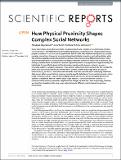| dc.contributor.author | Stopczynski, Arkadiusz | |
| dc.contributor.author | Pentland, Alex | |
| dc.contributor.author | Lehmann, Sune | |
| dc.date.accessioned | 2021-03-29T15:15:42Z | |
| dc.date.available | 2021-03-29T15:15:42Z | |
| dc.date.issued | 2018-12-07 | |
| dc.identifier.uri | https://hdl.handle.net/1721.1/130252 | |
| dc.description.abstract | Social interactions among humans create complex networks and – despite a recent increase of online communication – the interactions mediated through physical proximity remain a fundamental way for people to connect. A common way to quantify the nature of the links between individuals is to consider repeated interactions: frequently occurring interactions indicate strong ties, such as friendships, while ties with low weights can indicate random encounters. Here we focus on a different dimension: rather than the strength of links, we study physical distance between individuals when a link is activated. The findings presented here are based on a dataset of proximity events in a population of approximately 500 individuals. To quantify the impact of the physical proximity on the dynamic network, we use a simulated epidemic spreading processes in two distinct networks of physical proximity. We consider the network of short-range interactions defined as d ≲
≲
1 meter, and the long-range which includes all interactions d ≲
≲
10 meters. Since these two networks arise from the same set of underlying behavioral data, we are able to quantitatively measure how the specific definition of the proximity network – short-range versus long-range – impacts the resulting network structure as well as spreading dynamics in epidemic simulations. We find that the short-range network – consistent with the literature – is characterized by densely-connected neighborhoods bridged by weak ties. More surprisingly, however, we show that spreading in the long-range network is quite different, mainly shaped by spurious interactions. | en_US |
| dc.language.iso | en | en_US |
| dc.publisher | Scientific Reports | en_US |
| dc.rights | Attribution-NonCommercial-ShareAlike 3.0 United States | * |
| dc.rights.uri | http://creativecommons.org/licenses/by-nc-sa/3.0/us/ | * |
| dc.title | How Physical Proximity Shapes Complex Social Networks | en_US |
| dc.type | Article | en_US |
| dc.identifier.citation | Stopczynski, A., Pentland, A. & Lehmann, S. (2018). How physical proximity shapes complex social networks. Scientific reports, 8(1), 1-10. | en_US |
| dc.contributor.department | MIT Connection Science (Research institute) | |
